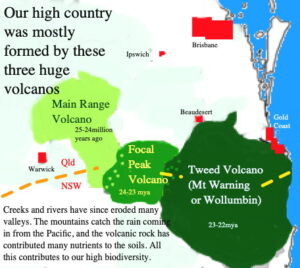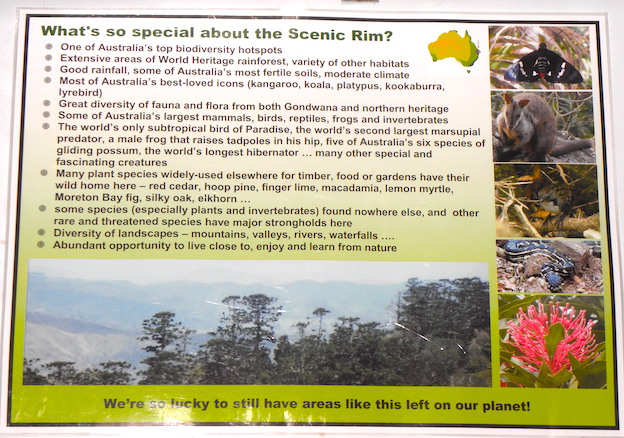This page is the result of two workshops held in the Scenic Rim in May 2024.
Three main considerations:
- What wildlife do we have in the Scenic Rim and why is it special?
- What are some of their major ecological needs?
- How can local businesses help?
What wildlife do we have in the Scenic Rim and why is it special?
We live in a very special part of Australia.
Volcanoes erupting between 25 and 22 million years ago gave us a rich diversity of topography and fertile soils and also catch rain from clouds rolling in from the Pacific.

Volanoes of the Scenic Rim: courtesy Scenic Rim Wildlife Ecology Centre, Araucaria Ecotours
This has resulted in a high diversity of wildlife.
“The Clarence-Moreton Bioregion is one of the most biologically diverse regions in Australia. It includes the ‘Macleay–McPherson Overlap’, an area where a combination of climate and geography have resulted in the co-occurrence of both temperate and tropical species and a substantial number of regionally endemic species”.(Burbidge 1960). (Bioregional assessments, Australian Government). The Scenic Rim lies within this special part of se Queensland and ne NSW

Poster summarising some special features of the Scenic Rim: courtesy Scenic Rim Wildlife Ecology Centre, Araucaria Ecotours
Almost all Australian families of mammals are found in the Scenic Rim, and our mammals include the world’s three great mammalian groups: monotremes, marsupials and placentals.
Roughly half of all Australian birds, including all its raptors, have been seen in Southeast Queensland. And we have some very special species, including lyrebird, two bowerbirds, a logunner and a bird of paradise, along with famous ones such as kookaburra, wedge-tailed eagle and several cockatoos, and endangered ones such as the eastern bristlebird and Coxen’s figparrot.
All Australian snake families and all Australian lizard families are represented in the Scenic Rim, and we have three species of freshw/ater turtles. We are also known as a hotspot for frog species.
We have one of Australia’s highest diversities of land snails, Australia’s second and third largest butterflies, the Lamington cray and a great diversity of other invertebrates.
For more details see https://scenicrim.wildlife.org.au/the-region-its-wildlife/wildlife-of-the-scenic-rim-overview/
What are some of their major ecological needs?
Basically all animals need to:
- find accessible and appropriate food, and usually in all seasons
- have access to water for drinking or leaves with sufficient moisture in all seasons
- have shelter from extremes of weather and from predators
- avoid predators and/or parasites
- avoid other hazards
- find mates and have appropriate resources for raising young
- move when necessary (to follow food or water, escape severe fire or other disaster, seasonal migration, young animals seeking new territories …)
How can local businesses help?
Tourism businesses can practice:
- Minimal impact wildlife viewing: don’t disturb natural behaviour, walk and talk quietly, keep recorded birdcalls to a minimum, don’t shine bright lights directly into faces of animals when spotlighting …)
- Quality interpretation of wildlife to enhance appreciation and understanding
- Conservation volunteering: local seed collection and planting of wildlife-friendly tree and shrubs; pulling weeds that impede native plant growth koalas moving between trees or platypus establishing burrows; preparing food for orphaned animals raised by licensed carers …
- Citizen science: photographic record of flowering and fruiting seasons and animal visits to fruits and flowers; setting motion-sensing cameras, direct observations of presence and behaviour of threatened species
- Buying local and sustainable products to indirectly assist wildlife here and elsewhere: paper and timber recycled or from plantation timber; takeaway utensils bamboo instead of plastic; local food product (thus reducing long-distance transport with fossil fuels); buying from farmers who conserve wildlife habitat and use pesticides carefully if at all
- General sustainability: reduce and recycle waste, don’t waste water …
Also check out Ecotourism Australia’s sustainability scorecard (for all tourism businesses, not just ecotours) https://www.ecotourism.org.au/strive-4-sustainability
Wildlife-friendly Plant Species for the Scenic Rim (pdf)
Any property with available land:
- Planting local natives for multiple wildlife species (mammals, birds, lizards, butterflies, native bees…) as standalone or adding to corridor routes
- Protecting locally-native plants already present
- Provide water in drought times
- Nest boxes in appropriate situation where there are insufficient old trees with hollow trunks or branches for parrots, owls, glide etc.
- Responsible pest control: highly-targeted application, choice of least harmful products, consideration of other control methods (e.g. traps instead of rat bait, covering crops or individual food-pants with mesh that won’t entangle birds or bats)
Farming properties
- Conserve clumps of trees, including some with understory
- Leave single trees standing in paddock, (assists movement of birds, koalas, gliders etc., and even dead ones can have hollows for parrots or sturdy branches for eagle nests)
- Responsible pest control (see https://www.turfbreed.com.au/are-you-chemical-compliant/, https://www.coolturf.com.au/about-us/why-coolabah/, https://www.epa.gov/safepestcontrol/tips-reducing-pesticide-impacts-wildlife)
- Mosaic burns, not too often, too hot or in major breeding season (a lot of collaboration is happening nowadays between First Nations people and wildlife ecologists to work out the optimum regimes for different species)
- Protect platypus burrows from trampling by castle
- Control feral animals (especially cats, foxes, cane toads and fire ants) and troublesome weeds
- Use wildlife-friendly fencing (https://wildlifefriendlyfencing.org)
Retailers and wholesalers:
- Buying local and sustainable products
- General sustainability
- Ethical products




